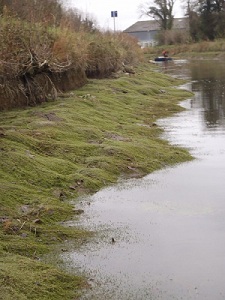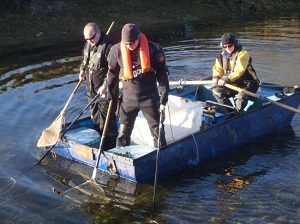
New Zealand Pigmyweed (Crassula helmsii) is an aggressive alien invasive weed that was introduced to Ireland as an ornamental species for use in the horticulture trade. It can grow submerged in up to 2 m water depth but is also capable of growing out of water.
It can grow luxuriantly when it is introduced to suitable habitats and will rapidly overgrow all native plant species, thus significantly reducing biodiversity. Its dense vegetation will choke the water column and make it impossible for fish to move about normally. The thick weed will also clog the propellers of boats while also obstructing angling.
Currently, the New Zealand Pigmyweed is relatively restricted in its distribution within the Grand Canal and is only recorded between Kilpatrick and Ticknevin Bridges, a distance of circa 2.2 km. Such is the invasiveness of this high priority invasive weed, however, that it will rapidly spread within the canal corridor and overgrow many miles of channel.
The New Zealand Pigmyweed is named in the Third Schedule of the new Birds and Natural Habitats Regulations (2011) as a non-native species that is subject to restrictions under Regulations 49 and 50. These Regulations were only signed into law in October 2011. Under these Regulations it is an offence to release or allow to escape, to plant, disperse or allow or cause to disperse, to breed, propagate, import, transport, sell or advertise any of the species included in this black list, save in accordance with a licence granted under paragraph (7) of Regulation 49.
IFI made Waterways Ireland aware of the presence of this invasive species in their canal and of the risks that it posed to native biodiversity, water movement and recreational exploitation in this ecosystem. They immediately resolved to make every effort to eradicate the weed and its associated risks. IFI scientists worked closely with WI engineers and a plan to remove the weed was developed.

As such, on-site preparatory work to eradicate this invasive weed has already commenced. Water is currently being pumped out from the confined section of canal in order to let the channel dry out to facilitate the chemical treatment of the weed with an approved herbicide and adjuvant. IFI and CAISIE staff have also removed fish present via electrofishing and relocated them to an adjacent canal section. It is planned to treat the New Zealand Pigmyweed in early December once the channel has drained and the weather is suitable. WI will then remove the dams and rewater the channel. The success of the operation will be monitored throughout 2012 by IFI scientists.
Source: caisie – Eradication of a Highly Invasive Weed in the Grand Canal





